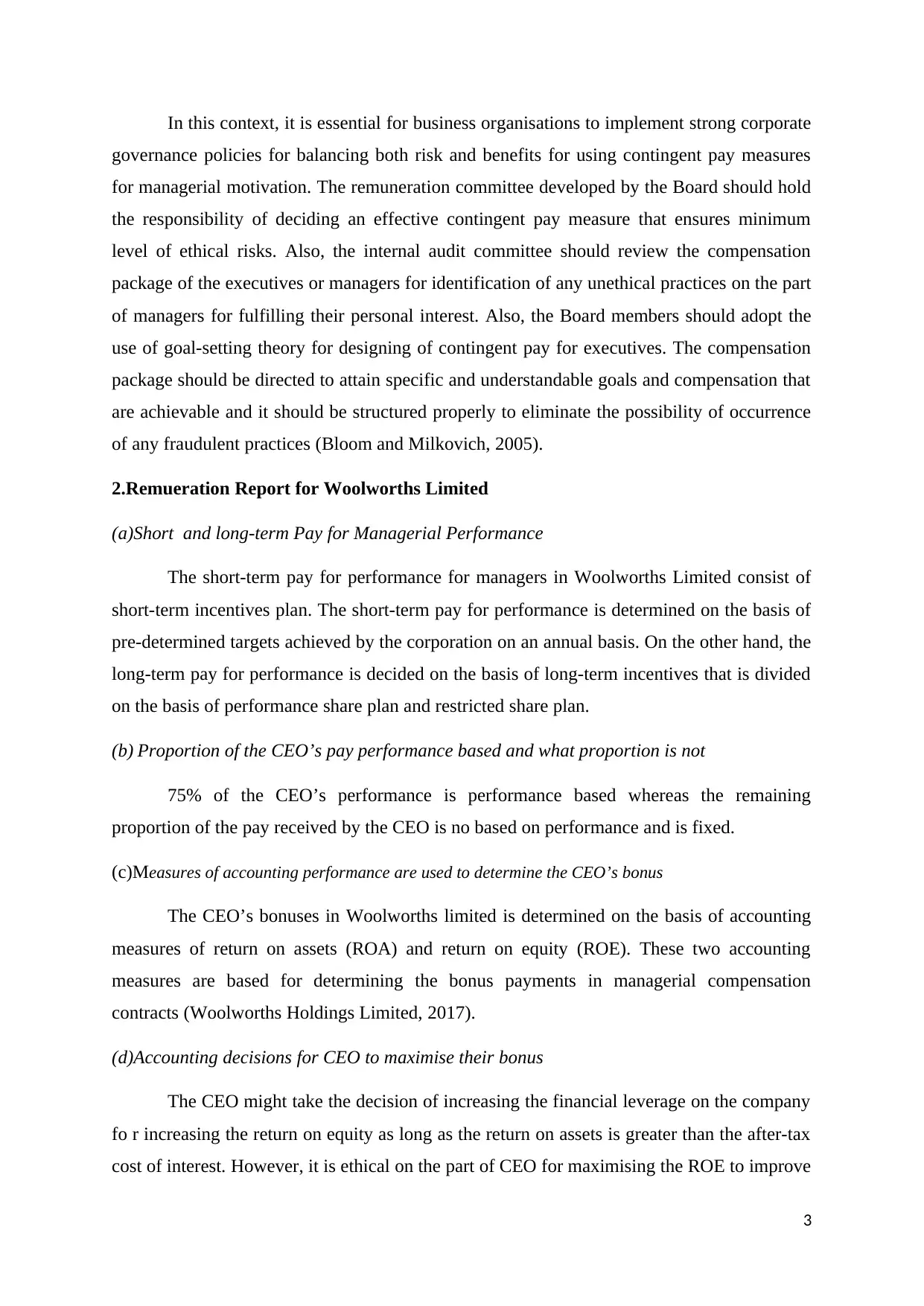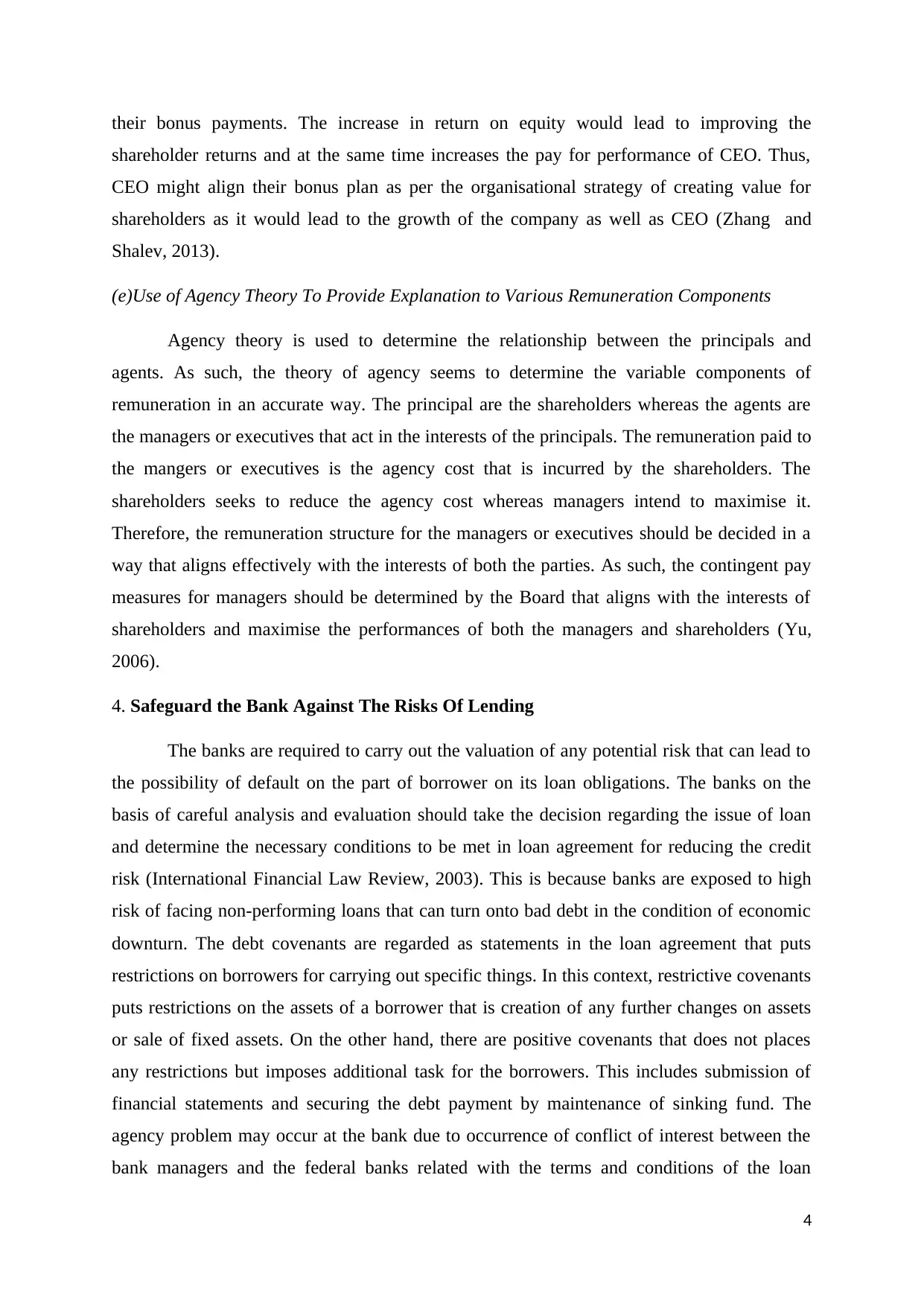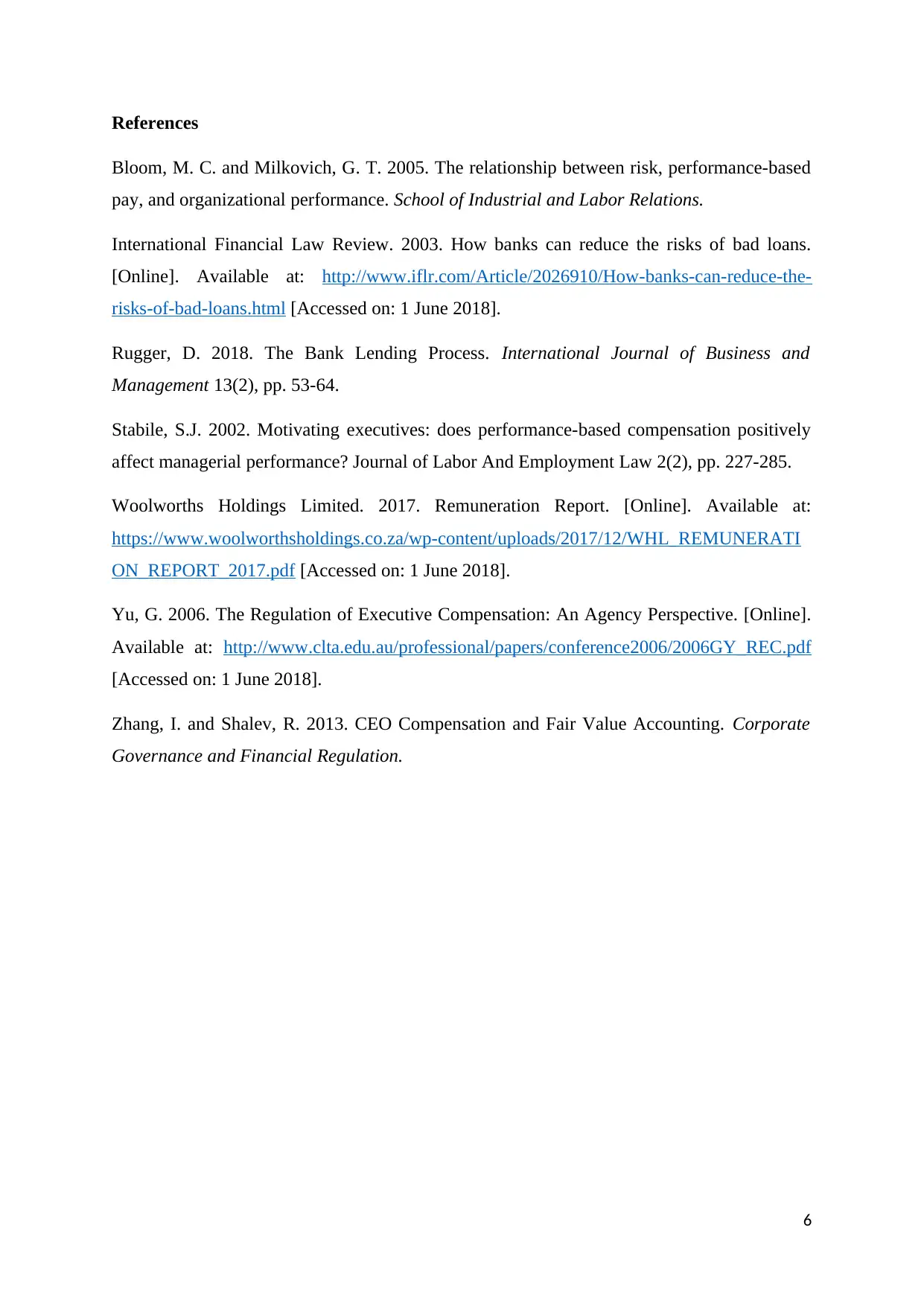ACC307 Accounting Theory: Executive Pay and Corporate Governance
VerifiedAdded on 2023/06/11
|6
|1620
|337
Report
AI Summary
This report delves into various aspects of accounting theory, primarily focusing on managerial compensation and the associated risks and benefits. It examines how contingent pay, which is performance-based compensation for executives, can motivate superior performance but also incentivize unethical practices to manipulate financial information. The report emphasizes the importance of strong corporate governance policies and internal audit committees to balance these risks. It also includes an analysis of Woolworths Limited's remuneration report, focusing on the CEO's pay structure, performance measures, and the application of agency theory in determining remuneration components. Furthermore, the report discusses how banks can safeguard against lending risks through careful risk assessment, debt covenants, and the use of accounting information to evaluate potential borrowers. The solutions provided offer insights into aligning managerial incentives with shareholder value while mitigating potential ethical concerns. Desklib provides access to similar solved assignments and past papers for students.

Accounting Theory
1
1
Paraphrase This Document
Need a fresh take? Get an instant paraphrase of this document with our AI Paraphraser

1.Managerial Contingent Pay
The term ‘contingent compensation’ refers to the performance based compensation
used for motivating the executives or managers of a business corporation for delivering
superior performance. The pay for performance part of compensation package developed for
executives can include short-term bonuses or long-term compensation such as stock options
or stock bonuses. The short-term incentives compensation package consists of annual
payments provided to executives on the basis of the company performance. The
compensation committee developed by the Board holds the responsibility of creating the
benchmarks of the company performance in specific categories such as earnings per share,
return on assets or return on equity. Thus, the managers or executives are provided the
bonuses if the corporate is able to achieve or exceed the benchmark. However, if the
determined targets are not achieved then manger or executives are paid small or no bonuses
(Stabile, 2002). Therefore, the pay to managers in such plans is contingent depend on the
corporate achievement of the specified objectives. The long-term compensation of stock
options refers to providing the option holder the right to purchase specific number of shares
at a fixed price on the grant date whereas bonus stock is free stock that provides
compensation to the managers irrespective of the rise or decrease in stock prices on the grant
date. All these contingent compensation strategies are used by Board members for motivating
them to deliver good performance and thus creative value for the shareholders. This si also
ascertained on the basis of agency theory as per which strategic use of contingent pay
improves the manger’s abilities and improved business outcomes as they places greater focus
on improving the corporate performance (Yu, 2006).
However, there is also increased risk for manipulation of accounting information by
the managers for increasing their pay for performance by depicting improved business
outcomes. The business risk that is likely to be induced in the income depiction or stock
returns of the corporations. The managers may adopt the use of unethical practices for
improving the business performances or implement the use of fraudulent accounting practices
for disclosing false financial information through its financial statements. The financial
conditions of a firm has a direct impact on the stock prices and thus largely determine the
long-term compensation of the managers. Thus, by using unethical business practices
mangers may tend to disrupt the financial information for achieving their personal motives
and thus creates risk for deceiving the investors or shareholders as they rely on financial
information disclosed for making investment decisions.
2
The term ‘contingent compensation’ refers to the performance based compensation
used for motivating the executives or managers of a business corporation for delivering
superior performance. The pay for performance part of compensation package developed for
executives can include short-term bonuses or long-term compensation such as stock options
or stock bonuses. The short-term incentives compensation package consists of annual
payments provided to executives on the basis of the company performance. The
compensation committee developed by the Board holds the responsibility of creating the
benchmarks of the company performance in specific categories such as earnings per share,
return on assets or return on equity. Thus, the managers or executives are provided the
bonuses if the corporate is able to achieve or exceed the benchmark. However, if the
determined targets are not achieved then manger or executives are paid small or no bonuses
(Stabile, 2002). Therefore, the pay to managers in such plans is contingent depend on the
corporate achievement of the specified objectives. The long-term compensation of stock
options refers to providing the option holder the right to purchase specific number of shares
at a fixed price on the grant date whereas bonus stock is free stock that provides
compensation to the managers irrespective of the rise or decrease in stock prices on the grant
date. All these contingent compensation strategies are used by Board members for motivating
them to deliver good performance and thus creative value for the shareholders. This si also
ascertained on the basis of agency theory as per which strategic use of contingent pay
improves the manger’s abilities and improved business outcomes as they places greater focus
on improving the corporate performance (Yu, 2006).
However, there is also increased risk for manipulation of accounting information by
the managers for increasing their pay for performance by depicting improved business
outcomes. The business risk that is likely to be induced in the income depiction or stock
returns of the corporations. The managers may adopt the use of unethical practices for
improving the business performances or implement the use of fraudulent accounting practices
for disclosing false financial information through its financial statements. The financial
conditions of a firm has a direct impact on the stock prices and thus largely determine the
long-term compensation of the managers. Thus, by using unethical business practices
mangers may tend to disrupt the financial information for achieving their personal motives
and thus creates risk for deceiving the investors or shareholders as they rely on financial
information disclosed for making investment decisions.
2

In this context, it is essential for business organisations to implement strong corporate
governance policies for balancing both risk and benefits for using contingent pay measures
for managerial motivation. The remuneration committee developed by the Board should hold
the responsibility of deciding an effective contingent pay measure that ensures minimum
level of ethical risks. Also, the internal audit committee should review the compensation
package of the executives or managers for identification of any unethical practices on the part
of managers for fulfilling their personal interest. Also, the Board members should adopt the
use of goal-setting theory for designing of contingent pay for executives. The compensation
package should be directed to attain specific and understandable goals and compensation that
are achievable and it should be structured properly to eliminate the possibility of occurrence
of any fraudulent practices (Bloom and Milkovich, 2005).
2.Remueration Report for Woolworths Limited
(a)Short and long-term Pay for Managerial Performance
The short-term pay for performance for managers in Woolworths Limited consist of
short-term incentives plan. The short-term pay for performance is determined on the basis of
pre-determined targets achieved by the corporation on an annual basis. On the other hand, the
long-term pay for performance is decided on the basis of long-term incentives that is divided
on the basis of performance share plan and restricted share plan.
(b) Proportion of the CEO’s pay performance based and what proportion is not
75% of the CEO’s performance is performance based whereas the remaining
proportion of the pay received by the CEO is no based on performance and is fixed.
(c)Measures of accounting performance are used to determine the CEO’s bonus
The CEO’s bonuses in Woolworths limited is determined on the basis of accounting
measures of return on assets (ROA) and return on equity (ROE). These two accounting
measures are based for determining the bonus payments in managerial compensation
contracts (Woolworths Holdings Limited, 2017).
(d)Accounting decisions for CEO to maximise their bonus
The CEO might take the decision of increasing the financial leverage on the company
fo r increasing the return on equity as long as the return on assets is greater than the after-tax
cost of interest. However, it is ethical on the part of CEO for maximising the ROE to improve
3
governance policies for balancing both risk and benefits for using contingent pay measures
for managerial motivation. The remuneration committee developed by the Board should hold
the responsibility of deciding an effective contingent pay measure that ensures minimum
level of ethical risks. Also, the internal audit committee should review the compensation
package of the executives or managers for identification of any unethical practices on the part
of managers for fulfilling their personal interest. Also, the Board members should adopt the
use of goal-setting theory for designing of contingent pay for executives. The compensation
package should be directed to attain specific and understandable goals and compensation that
are achievable and it should be structured properly to eliminate the possibility of occurrence
of any fraudulent practices (Bloom and Milkovich, 2005).
2.Remueration Report for Woolworths Limited
(a)Short and long-term Pay for Managerial Performance
The short-term pay for performance for managers in Woolworths Limited consist of
short-term incentives plan. The short-term pay for performance is determined on the basis of
pre-determined targets achieved by the corporation on an annual basis. On the other hand, the
long-term pay for performance is decided on the basis of long-term incentives that is divided
on the basis of performance share plan and restricted share plan.
(b) Proportion of the CEO’s pay performance based and what proportion is not
75% of the CEO’s performance is performance based whereas the remaining
proportion of the pay received by the CEO is no based on performance and is fixed.
(c)Measures of accounting performance are used to determine the CEO’s bonus
The CEO’s bonuses in Woolworths limited is determined on the basis of accounting
measures of return on assets (ROA) and return on equity (ROE). These two accounting
measures are based for determining the bonus payments in managerial compensation
contracts (Woolworths Holdings Limited, 2017).
(d)Accounting decisions for CEO to maximise their bonus
The CEO might take the decision of increasing the financial leverage on the company
fo r increasing the return on equity as long as the return on assets is greater than the after-tax
cost of interest. However, it is ethical on the part of CEO for maximising the ROE to improve
3
⊘ This is a preview!⊘
Do you want full access?
Subscribe today to unlock all pages.

Trusted by 1+ million students worldwide

their bonus payments. The increase in return on equity would lead to improving the
shareholder returns and at the same time increases the pay for performance of CEO. Thus,
CEO might align their bonus plan as per the organisational strategy of creating value for
shareholders as it would lead to the growth of the company as well as CEO (Zhang and
Shalev, 2013).
(e)Use of Agency Theory To Provide Explanation to Various Remuneration Components
Agency theory is used to determine the relationship between the principals and
agents. As such, the theory of agency seems to determine the variable components of
remuneration in an accurate way. The principal are the shareholders whereas the agents are
the managers or executives that act in the interests of the principals. The remuneration paid to
the mangers or executives is the agency cost that is incurred by the shareholders. The
shareholders seeks to reduce the agency cost whereas managers intend to maximise it.
Therefore, the remuneration structure for the managers or executives should be decided in a
way that aligns effectively with the interests of both the parties. As such, the contingent pay
measures for managers should be determined by the Board that aligns with the interests of
shareholders and maximise the performances of both the managers and shareholders (Yu,
2006).
4. Safeguard the Bank Against The Risks Of Lending
The banks are required to carry out the valuation of any potential risk that can lead to
the possibility of default on the part of borrower on its loan obligations. The banks on the
basis of careful analysis and evaluation should take the decision regarding the issue of loan
and determine the necessary conditions to be met in loan agreement for reducing the credit
risk (International Financial Law Review, 2003). This is because banks are exposed to high
risk of facing non-performing loans that can turn onto bad debt in the condition of economic
downturn. The debt covenants are regarded as statements in the loan agreement that puts
restrictions on borrowers for carrying out specific things. In this context, restrictive covenants
puts restrictions on the assets of a borrower that is creation of any further changes on assets
or sale of fixed assets. On the other hand, there are positive covenants that does not places
any restrictions but imposes additional task for the borrowers. This includes submission of
financial statements and securing the debt payment by maintenance of sinking fund. The
agency problem may occur at the bank due to occurrence of conflict of interest between the
bank managers and the federal banks related with the terms and conditions of the loan
4
shareholder returns and at the same time increases the pay for performance of CEO. Thus,
CEO might align their bonus plan as per the organisational strategy of creating value for
shareholders as it would lead to the growth of the company as well as CEO (Zhang and
Shalev, 2013).
(e)Use of Agency Theory To Provide Explanation to Various Remuneration Components
Agency theory is used to determine the relationship between the principals and
agents. As such, the theory of agency seems to determine the variable components of
remuneration in an accurate way. The principal are the shareholders whereas the agents are
the managers or executives that act in the interests of the principals. The remuneration paid to
the mangers or executives is the agency cost that is incurred by the shareholders. The
shareholders seeks to reduce the agency cost whereas managers intend to maximise it.
Therefore, the remuneration structure for the managers or executives should be decided in a
way that aligns effectively with the interests of both the parties. As such, the contingent pay
measures for managers should be determined by the Board that aligns with the interests of
shareholders and maximise the performances of both the managers and shareholders (Yu,
2006).
4. Safeguard the Bank Against The Risks Of Lending
The banks are required to carry out the valuation of any potential risk that can lead to
the possibility of default on the part of borrower on its loan obligations. The banks on the
basis of careful analysis and evaluation should take the decision regarding the issue of loan
and determine the necessary conditions to be met in loan agreement for reducing the credit
risk (International Financial Law Review, 2003). This is because banks are exposed to high
risk of facing non-performing loans that can turn onto bad debt in the condition of economic
downturn. The debt covenants are regarded as statements in the loan agreement that puts
restrictions on borrowers for carrying out specific things. In this context, restrictive covenants
puts restrictions on the assets of a borrower that is creation of any further changes on assets
or sale of fixed assets. On the other hand, there are positive covenants that does not places
any restrictions but imposes additional task for the borrowers. This includes submission of
financial statements and securing the debt payment by maintenance of sinking fund. The
agency problem may occur at the bank due to occurrence of conflict of interest between the
bank managers and the federal banks related with the terms and conditions of the loan
4
Paraphrase This Document
Need a fresh take? Get an instant paraphrase of this document with our AI Paraphraser

agreement. The accounting information proves to be highly critical for the bank managers to
assess the risk related with providing the financial loans. This involves examination of the
publicly available accounting information on potential borrower for identifying the credit
rating and take decisions on the basis of the credit history of the potential borrower (Rugger,
2018).
5
assess the risk related with providing the financial loans. This involves examination of the
publicly available accounting information on potential borrower for identifying the credit
rating and take decisions on the basis of the credit history of the potential borrower (Rugger,
2018).
5

References
Bloom, M. C. and Milkovich, G. T. 2005. The relationship between risk, performance-based
pay, and organizational performance. School of Industrial and Labor Relations.
International Financial Law Review. 2003. How banks can reduce the risks of bad loans.
[Online]. Available at: http://www.iflr.com/Article/2026910/How-banks-can-reduce-the-
risks-of-bad-loans.html [Accessed on: 1 June 2018].
Rugger, D. 2018. The Bank Lending Process. International Journal of Business and
Management 13(2), pp. 53-64.
Stabile, S.J. 2002. Motivating executives: does performance-based compensation positively
affect managerial performance? Journal of Labor And Employment Law 2(2), pp. 227-285.
Woolworths Holdings Limited. 2017. Remuneration Report. [Online]. Available at:
https://www.woolworthsholdings.co.za/wp-content/uploads/2017/12/WHL_REMUNERATI
ON_REPORT_2017.pdf [Accessed on: 1 June 2018].
Yu, G. 2006. The Regulation of Executive Compensation: An Agency Perspective. [Online].
Available at: http://www.clta.edu.au/professional/papers/conference2006/2006GY_REC.pdf
[Accessed on: 1 June 2018].
Zhang, I. and Shalev, R. 2013. CEO Compensation and Fair Value Accounting. Corporate
Governance and Financial Regulation.
6
Bloom, M. C. and Milkovich, G. T. 2005. The relationship between risk, performance-based
pay, and organizational performance. School of Industrial and Labor Relations.
International Financial Law Review. 2003. How banks can reduce the risks of bad loans.
[Online]. Available at: http://www.iflr.com/Article/2026910/How-banks-can-reduce-the-
risks-of-bad-loans.html [Accessed on: 1 June 2018].
Rugger, D. 2018. The Bank Lending Process. International Journal of Business and
Management 13(2), pp. 53-64.
Stabile, S.J. 2002. Motivating executives: does performance-based compensation positively
affect managerial performance? Journal of Labor And Employment Law 2(2), pp. 227-285.
Woolworths Holdings Limited. 2017. Remuneration Report. [Online]. Available at:
https://www.woolworthsholdings.co.za/wp-content/uploads/2017/12/WHL_REMUNERATI
ON_REPORT_2017.pdf [Accessed on: 1 June 2018].
Yu, G. 2006. The Regulation of Executive Compensation: An Agency Perspective. [Online].
Available at: http://www.clta.edu.au/professional/papers/conference2006/2006GY_REC.pdf
[Accessed on: 1 June 2018].
Zhang, I. and Shalev, R. 2013. CEO Compensation and Fair Value Accounting. Corporate
Governance and Financial Regulation.
6
⊘ This is a preview!⊘
Do you want full access?
Subscribe today to unlock all pages.

Trusted by 1+ million students worldwide
1 out of 6
Related Documents
Your All-in-One AI-Powered Toolkit for Academic Success.
+13062052269
info@desklib.com
Available 24*7 on WhatsApp / Email
![[object Object]](/_next/static/media/star-bottom.7253800d.svg)
Unlock your academic potential
Copyright © 2020–2025 A2Z Services. All Rights Reserved. Developed and managed by ZUCOL.





